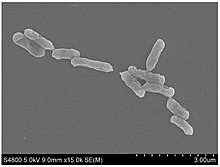| Acidithiobacillus | |
|---|---|

| |
| Acidithiobacillus ferrooxidans | |
| Scientific classification | |
| Domain: | Bacteria |
| Phylum: | Pseudomonadota |
| Class: | Acidithiobacillia |
| Order: | Acidithiobacillales |
| Family: | Acidithiobacillaceae |
| Genus: | Acidithiobacillus |
| Species | |
|
Acidithiobacillus albertensis | |
Acidithiobacillus is a genus of the Acidithiobacillia in the phylum "Pseudomonadota". This genus includes ten species of acidophilic microorganisms capable of sulfur and/or iron oxidation: Acidithiobacillus albertensis, Acidithiobacillus caldus, Acidithiobacillus cuprithermicus, Acidithiobacillus ferrianus, Acidithiobacillus ferridurans, Acidithiobacillus ferriphilus, Acidithiobacillus ferrivorans, Acidithiobacillus ferrooxidans, Acidithiobacillus sulfuriphilus, and Acidithiobacillus thiooxidans.[1] A. ferooxidans is the most widely studied of the genus, but A. caldus and A. thiooxidans are also significant in research. Like all "Pseudomonadota", Acidithiobacillus spp. are Gram-negative and non-spore forming.[2] They also play a significant role in the generation of acid mine drainage; a major global environmental challenge within the mining industry.[3] Some species of Acidithiobacillus are utilized in bioleaching and biomining.[4] A portion of the genes that support the survival of these bacteria in acidic environments are presumed to have been obtained by horizontal gene transfer.[5]
- ^ Moya-Beltrán, Ana; Beard, Simón; Rojas-Villalobos, Camila; Issotta, Francisco; Gallardo, Yasna; Ulloa, Ricardo; Giaveno, Alejandra; Degli Esposti, Mauro; Johnson, D. Barrie; Quatrini, Raquel (2021). "Genomic evolution of the class Acidithiobacillia: deep-branching Proteobacteria living in extreme acidic conditions". The ISME Journal. 15 (11): 3221–3238. Bibcode:2021ISMEJ..15.3221M. doi:10.1038/s41396-021-00995-x. ISSN 1751-7362. PMC 8528912. PMID 34007059.
- ^ Kumar, Pankaj; Jyoti, Bhim; Kumar, Ajay; Paliwal, Arunima (2019), Smart Bioremediation Technologies: Microbial Enzymes, Elsevier, pp. 137–158, doi:10.1016/b978-0-12-818307-6.00008-1, ISBN 978-0-12-818307-6, S2CID 199107288, retrieved 2023-04-23
- ^ International Network for Acid Prevention, GARD Guide, Chapter 2 Accessed July 2018.
- ^ Quatrini, Raquel; Jedlicki, Eugenia; Holmes, David S. (2005). "Genomic insights into the iron uptake mechanisms of the biomining microorganism Acidithiobacillus ferrooxidans". Journal of Industrial Microbiology and Biotechnology. 32 (11–12): 606–614. doi:10.1007/s10295-005-0233-2. PMID 15895264. S2CID 35943141 – via Oxford Academic.
- ^ González-Rosales, Carolina; Vergara, Eva; Dopson, Mark; Valdés, Jorge H.; Holmes, David S. (2022). "Integrative Genomics Sheds Light on Evolutionary Forces Shaping the Acidithiobacillia Class Acidophilic Lifestyle". Frontiers in Microbiology. 12: 822229. doi:10.3389/fmicb.2021.822229. ISSN 1664-302X. PMC 8886135. PMID 35242113.